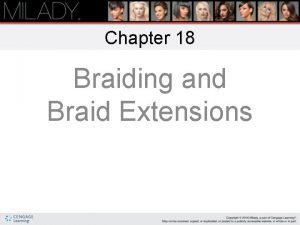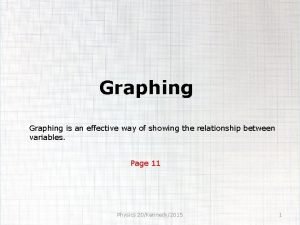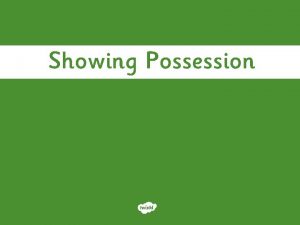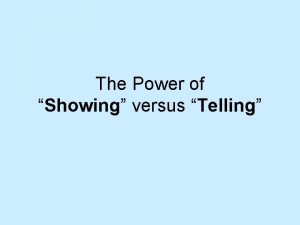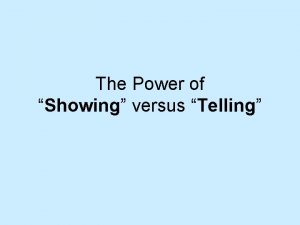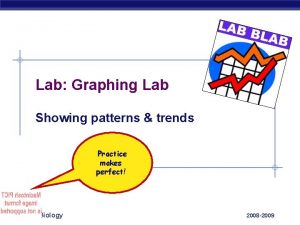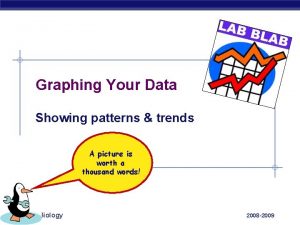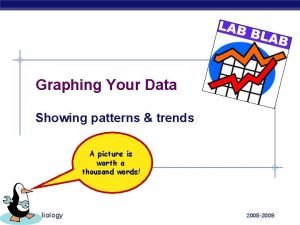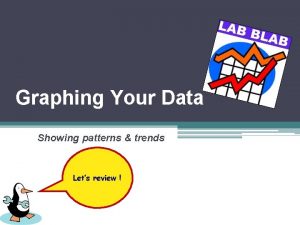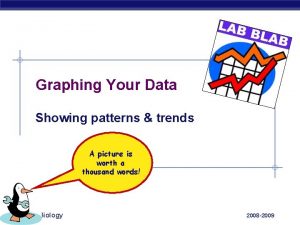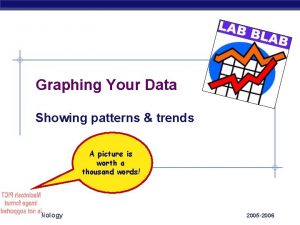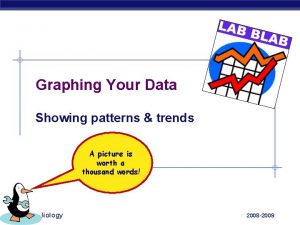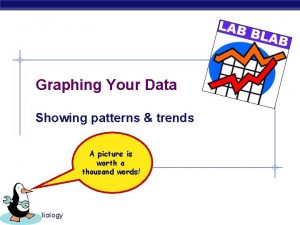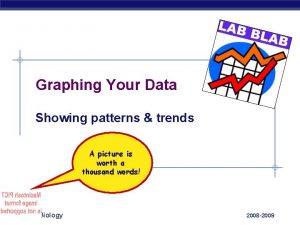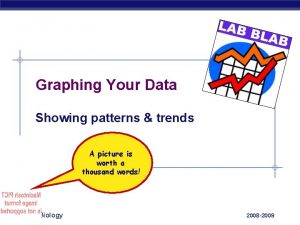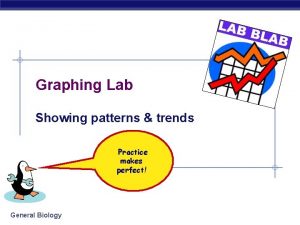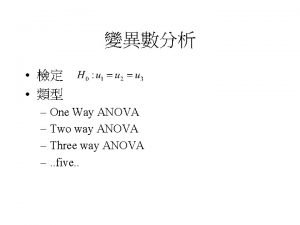Graphing is an effective way of showing the

























- Slides: 25

Graphing is an effective way of showing the relationship between variables. Page 24 Science 10/Kennedy/2016 1

1. 5 Graphing Page 24 Graphing experimental data is an effective way of showing relationships between variables. Science 10/Kennedy/2016 2

Graphing techniques Page 24 Graphs are used to communicate relationships – how one thing affects another. Step Step 1: 2: 3: 4: 5: 6: Select the Axes Select a Scale Plot the Data Draw the Best-fit Line Title (responding versus manipulated) Calculate slope Your graph should be neat and not cluttered. Science 10/Kennedy/2016 3

Graphing techniques Page 24 Graphs are used to communicate relationships – how one thing affects another. Step 1: Select the Axes Responding y Manipulated x Time is always on the x-axis Science 10/Kennedy/2016 4

Step 2: Select a Scale Page 24 Bad Good 3. 0 2. 0 1. 0 The graph should take up at least 2/3 of the graph paper. Science 10/Kennedy/2016 5

Page 24 Select whichever orientation works best for your graph. Portrait view Landscape view Science 10/Kennedy/2016 6

Page 24 Don’t crowd the axis. 6. 0 8. 0 1. 0 3. 0 2. 0 4. 0 5. 0 7. 0 9. 0 10. 0 15. 0 20. 0 25. 0 Poor Good Science 10/Kennedy/2016 7

When drawing a graph have a: • clear, plastic ruler/straight edge. You need to be able to see through the ruler to graph properly. • sharp pencil. Thin lines are more precise and produce better results. Whenever you have to draw a straight line, use a ruler/straight edge. Science 10/Kennedy/2016 8

Step 3: Plot the Data Page 24 1. Place a dot at the data point 2. Circle the data point Science 10/Kennedy/2016 9

Step 4: Draw the Best-fit Line Page 24 A good best fit line should: • Have as many dots as possible on the line. • Have as many dots above the line as below • All the dots as close as possible to the line Science 10/Kennedy/2016 10

Step 4: Draw the Best-fit Line Page 24 Best-fit lines and data points A best fit line should be as close as possible to all the points. This will result in as many points above the line as are before the line. A best fit line results in a type of average Do not connect the dots! A good best fit line should: • Have as many dots as possible on the line. • Have as many dots above the line as below • All the dots as close as possible to the line Science 10/Kennedy/2016 11

Page 24 Best fit lines Connect the dots – bad! Best fit line – good Use a clear plastic straight edge for best results Science 10/Kennedy/2016 12

Page 24 When drawing the best fit line, lift your pencil so as not to draw over the data point Science 10/Kennedy/2016 13

Lines Connect the dots – bad! Force through zero – bad! Connect first to last – bad! Best fit line – good! Science 10/Kennedy/2016 14

Page 24 Extrapolate and interpolate Extrapolate is extending the line beyond available data Interpolate is drawing a line between available data Science 10/Kennedy/2016 15

Page 34 Stray data points If a data point does not line up well with the rest of the dots then you may reject it as bad data. Draw an x through it or a place a question mark beside it. 40. 0 Mass (g) 30. 0 20. 0 10 20 30 40 50 Volume (m. L) Science 10/Kennedy/2016 16

Step 5: Title (responding versus manipulated) Example: Distance versus time Distance as a function of time Page 25 Mass of water as a function of Volume 40. 0 Mass (g) 30. 0 20. 0 10 20 30 40 50 Volume (m. L) Science 10/Kennedy/2016 17

Step 6: Calculate Slope • • Page 25 Slope is a measure of steepness of a line The symbol “m” is often used for slope Slope is the same anywhere on the straight line. Science 10/Kennedy/2016 18

Identify the line having the greater slope. A Steeper, therefore greater slope B Science 10/Kennedy/2016 19

Negative slope y y Positive slope x x Undefined slope y y Zero slope x x Science 10/Kennedy/2016 20

When calculating slope: Page 25 • Don’t use data points as slope points • Select two points that are relatively far apart • Use your clear plastic ruler 40. 0 to carefully mark the two slope points Mass of water as a function of Volume 38, 37. 5 Mass (g) 30. 0 20. 0 12. 0, 11. 6 10. 0 10 20 30 40 50 Volume (m. L) Science 10/Kennedy/2016 21

Page 25 Calculating Slope • Don’t use data points as slope points • Select two points that are relatively far apart • Use your clear plastic ruler to carefully mark the two slope points • As best as possible, use points that are easy to estimate; places where the graph line crosses grid lines. Science 10/Kennedy/2016 22

Selecting and marking slope points: Page 25 • You may select points that are as easy to read (estimate) as possible but make sure your estimate is actually on the graph. • Don’t use the nearest intersection to your best fit line • Take more care and mark slope points on the line. Science 10/Kennedy/2016 23

Page 25 Calculating Slope = rise run y 2 – y 1 x 2 – x 1 Show all work: 1. formula 2. substitution with units 3. answer Science 10/Kennedy/2016 24

Page 27 If your graph curves you can use a flexible ruler or free-hand the line Distance as a function of Time 4. 0 distance (m) 3. 0 2. 0 1. 0 2. 0 3. 0 time (s) Science 10/Kennedy/2016 4. 0 5. 0 p. 24 #1 - 6 Do 25
 Partial view controller
Partial view controller Milady chapter 18 review questions and answers
Milady chapter 18 review questions and answers Ways to refuse peer pressure
Ways to refuse peer pressure One-way anova hypothesis testing
One-way anova hypothesis testing When i was one i had just begun the day i went to sea
When i was one i had just begun the day i went to sea Perbedaan one way dan two way anova
Perbedaan one way dan two way anova One way anova vs two way anova
One way anova vs two way anova Talk this way
Talk this way Threaded binary tree in data structure
Threaded binary tree in data structure Contoh soal two way anova
Contoh soal two way anova Perbedaan two way anova dan one way anova
Perbedaan two way anova dan one way anova Conventional software
Conventional software Frequency trig
Frequency trig Bổ thể
Bổ thể Từ ngữ thể hiện lòng nhân hậu
Từ ngữ thể hiện lòng nhân hậu Diễn thế sinh thái là
Diễn thế sinh thái là Tư thế ngồi viết
Tư thế ngồi viết Lp html
Lp html Thế nào là giọng cùng tên? *
Thế nào là giọng cùng tên? * 101012 bằng
101012 bằng Chúa yêu trần thế alleluia
Chúa yêu trần thế alleluia Hổ sinh sản vào mùa nào
Hổ sinh sản vào mùa nào đại từ thay thế
đại từ thay thế Vẽ hình chiếu vuông góc của vật thể sau
Vẽ hình chiếu vuông góc của vật thể sau Công của trọng lực
Công của trọng lực Tỉ lệ cơ thể trẻ em
Tỉ lệ cơ thể trẻ em

